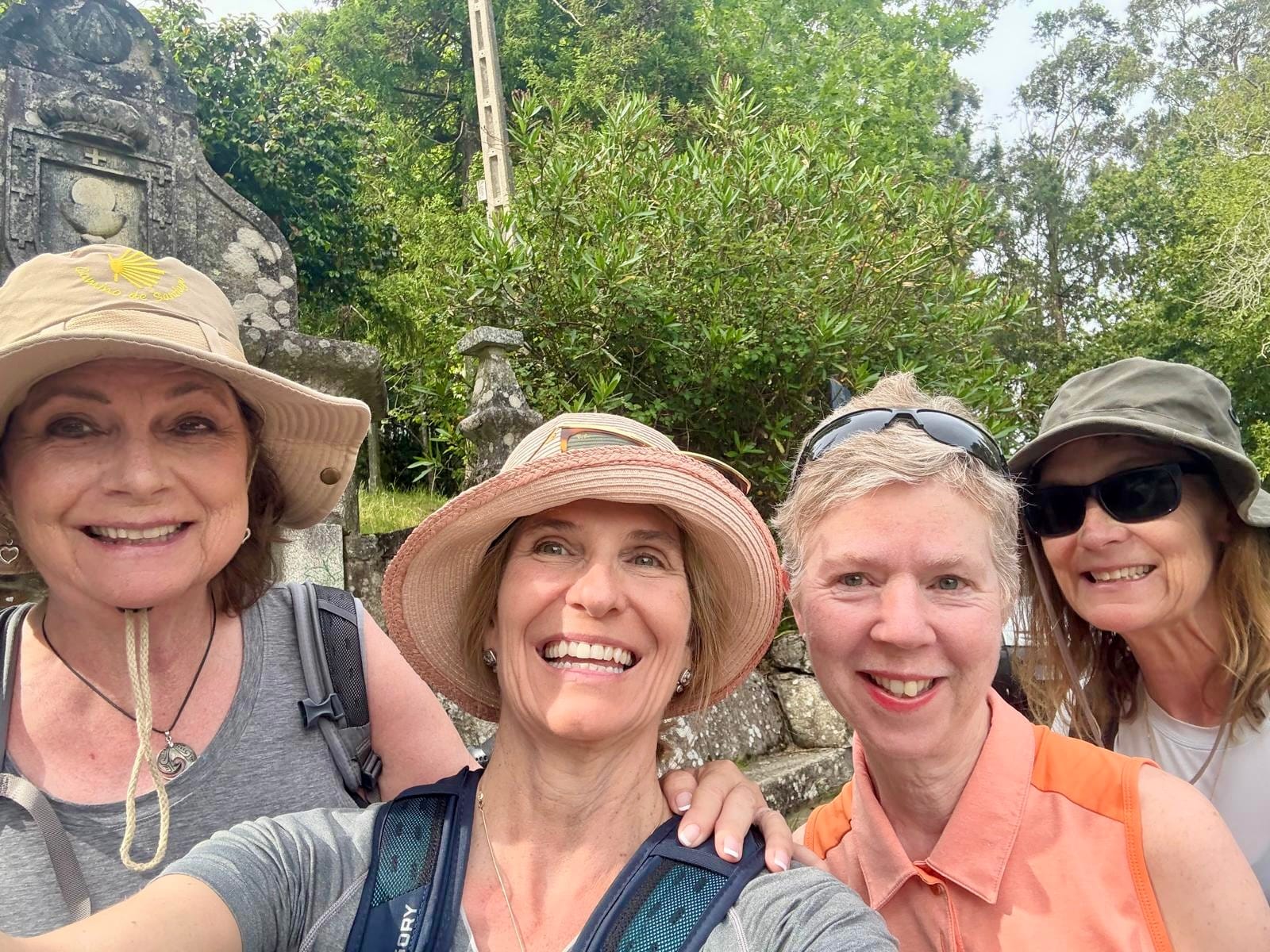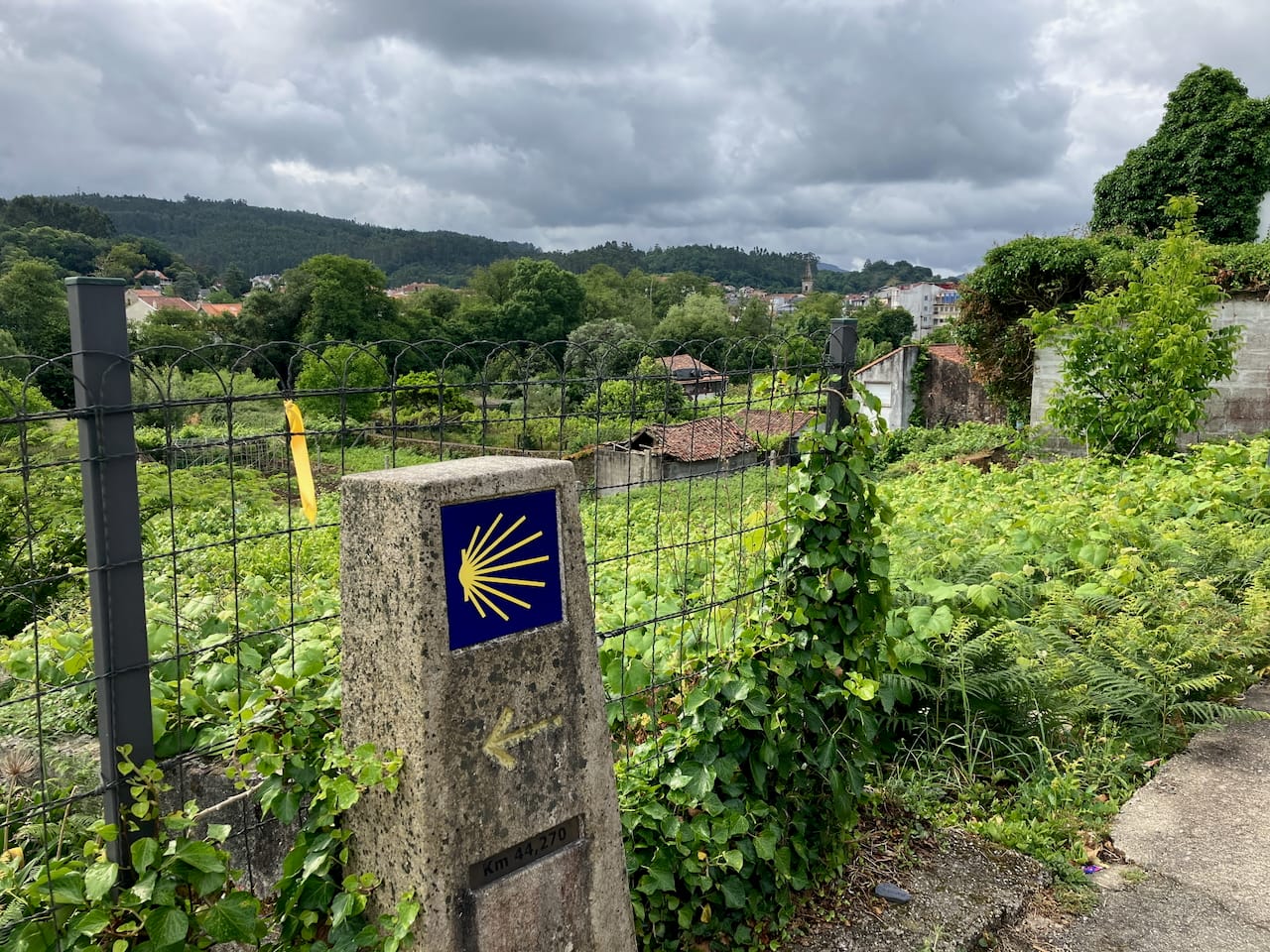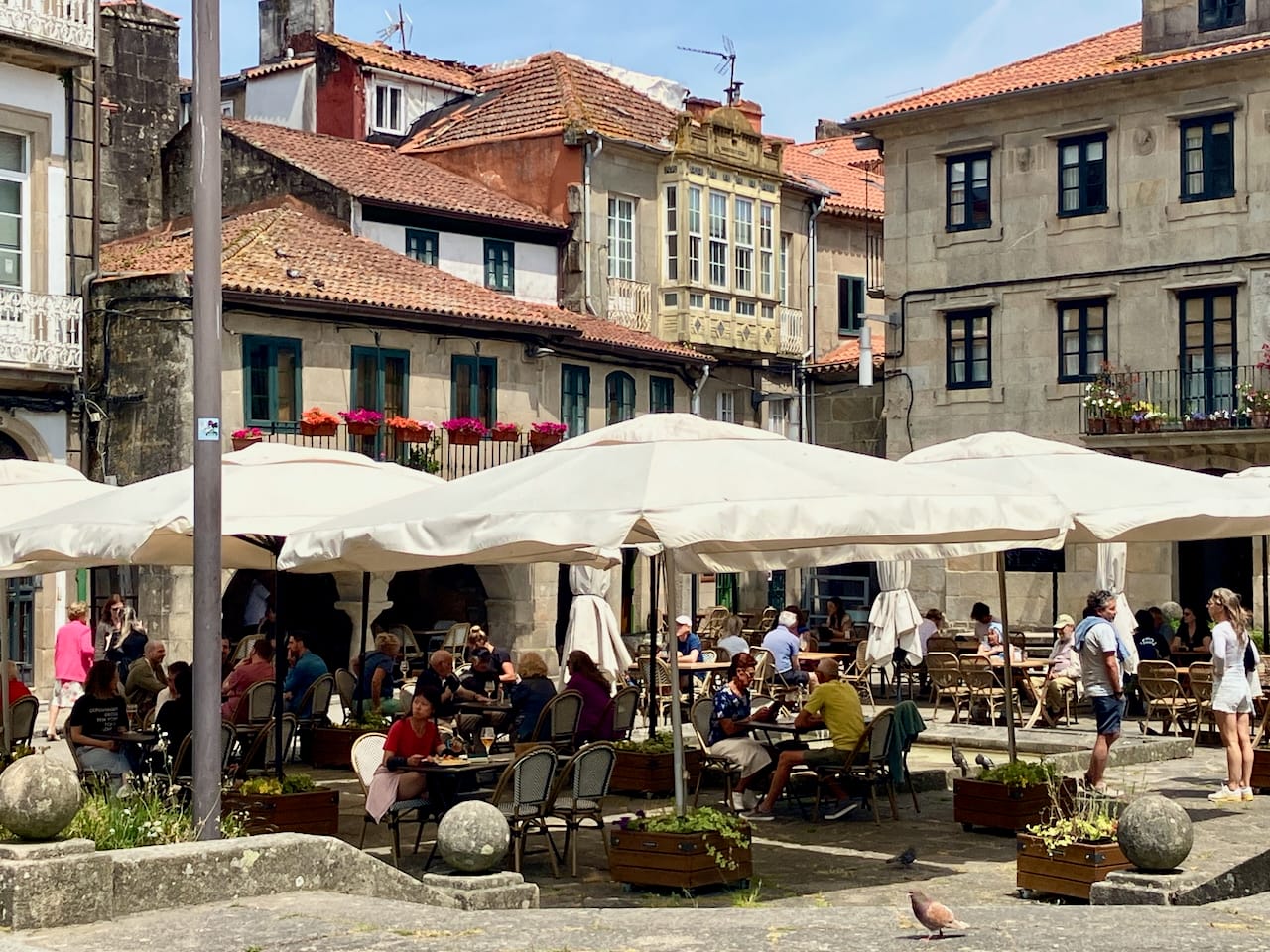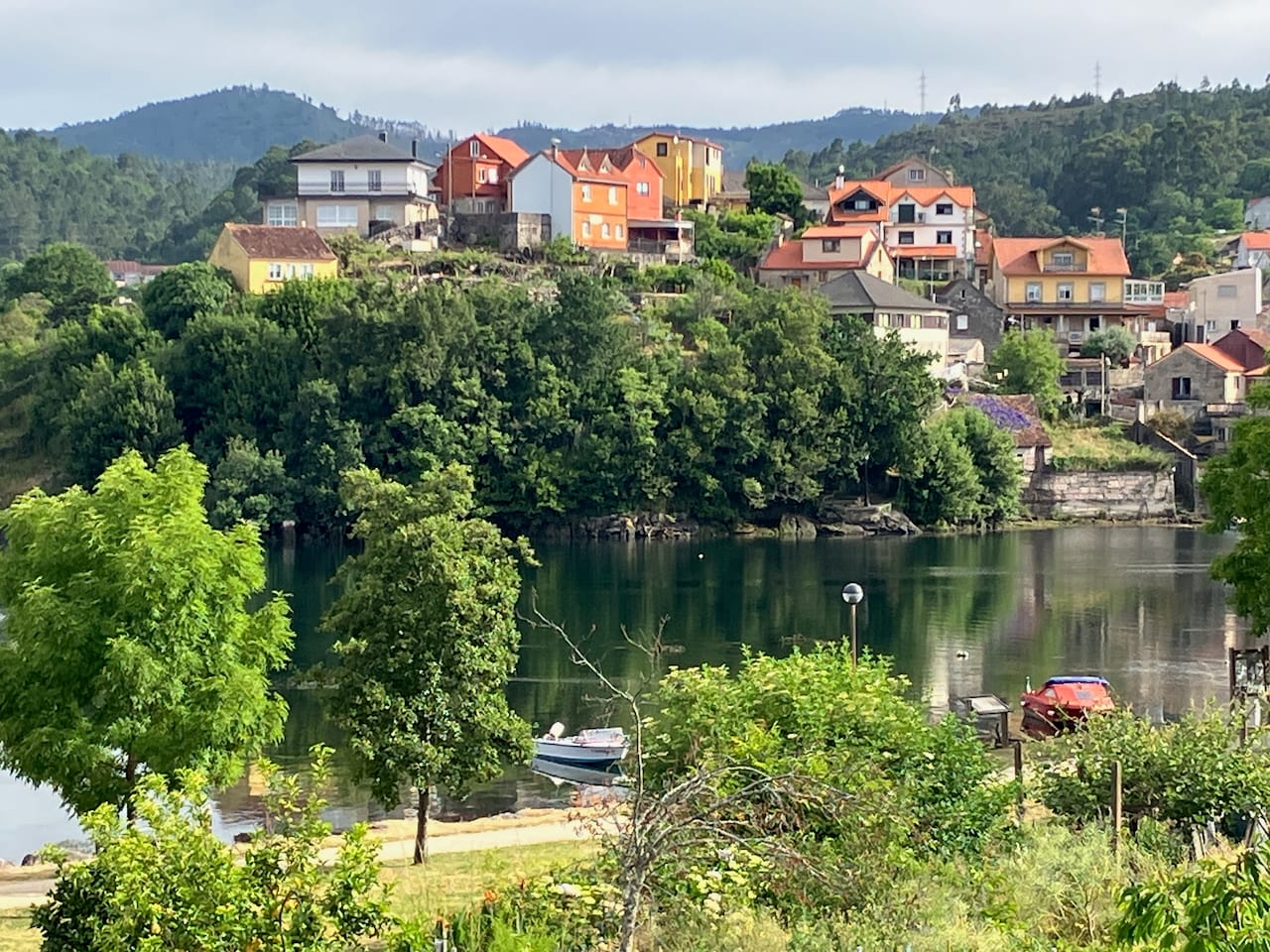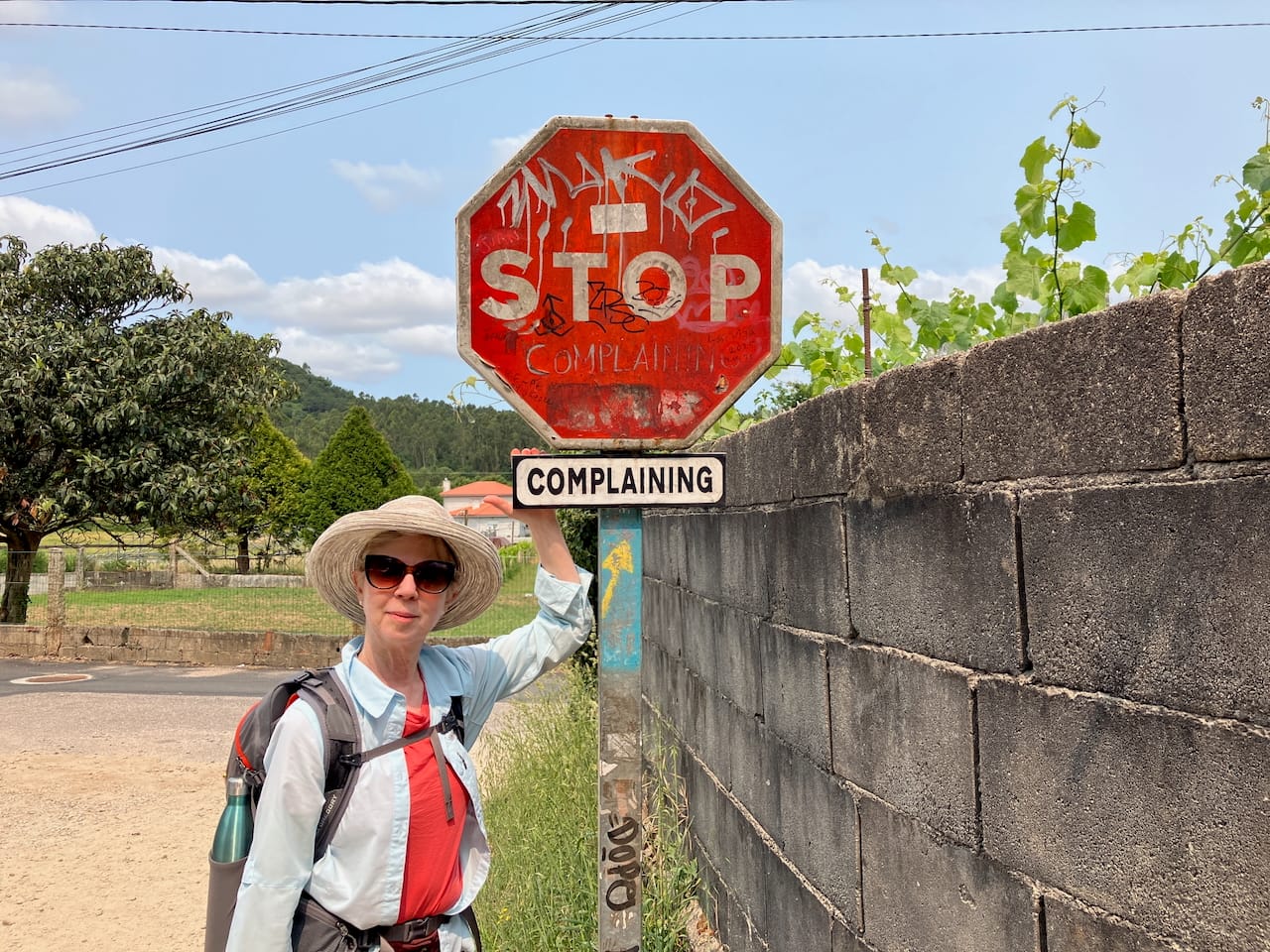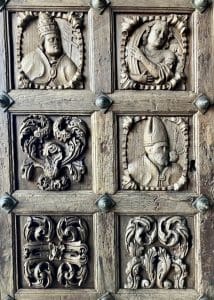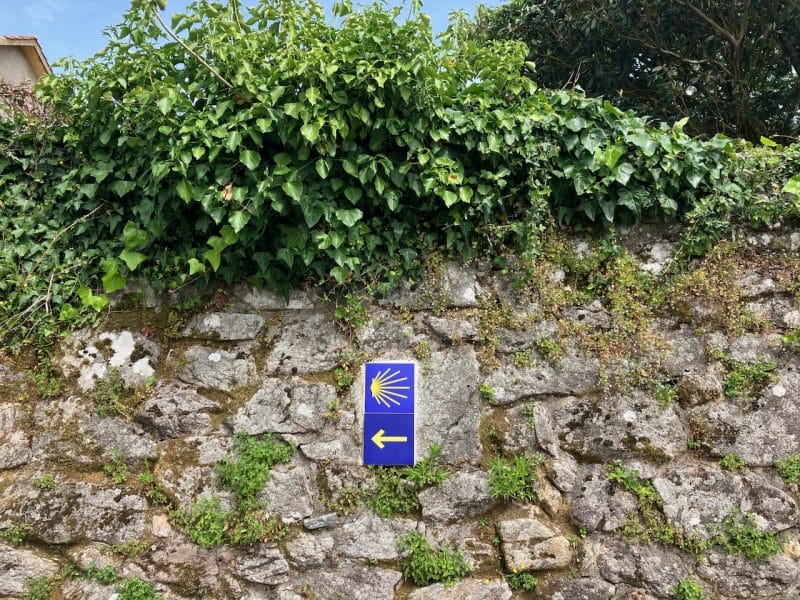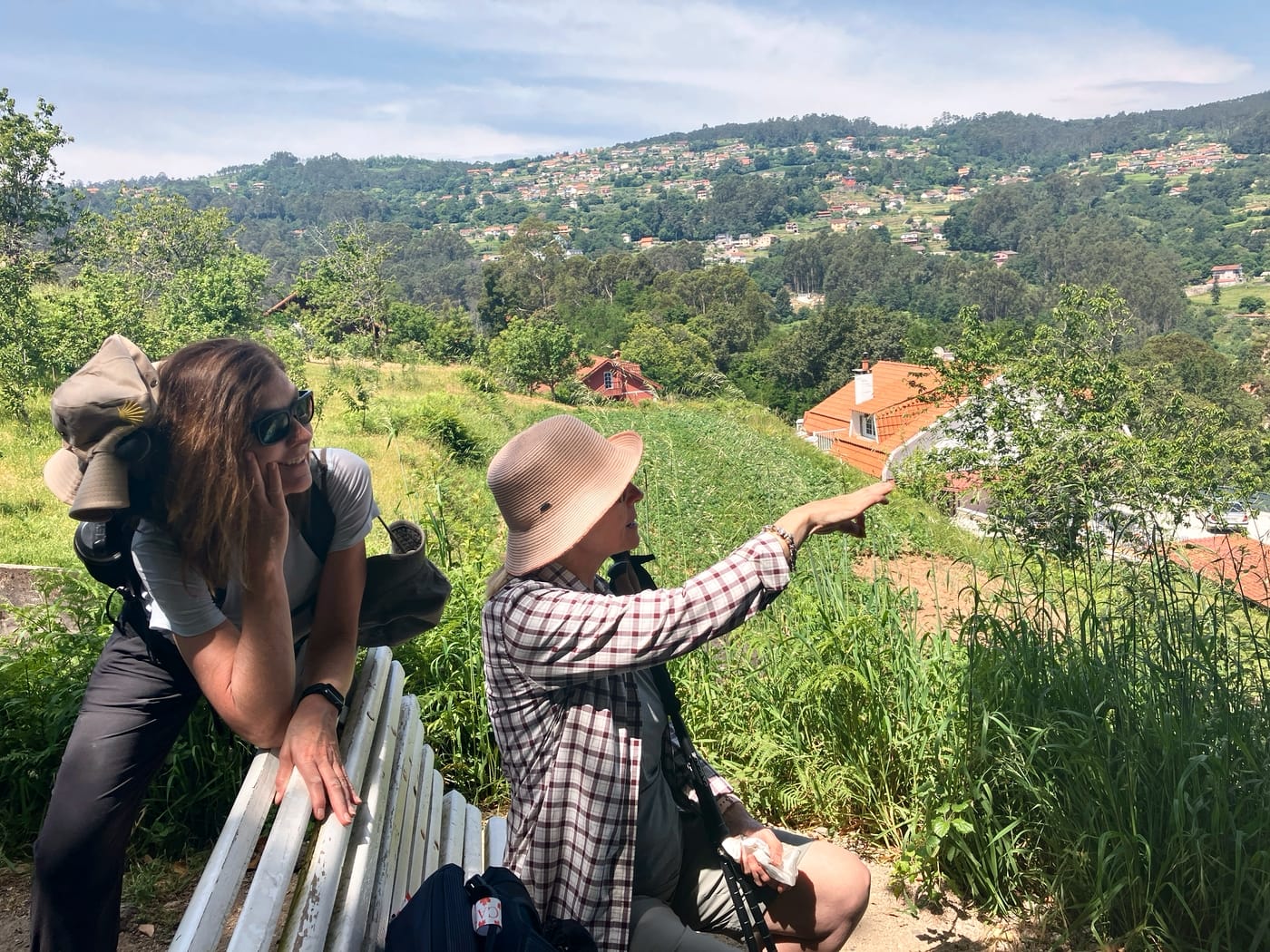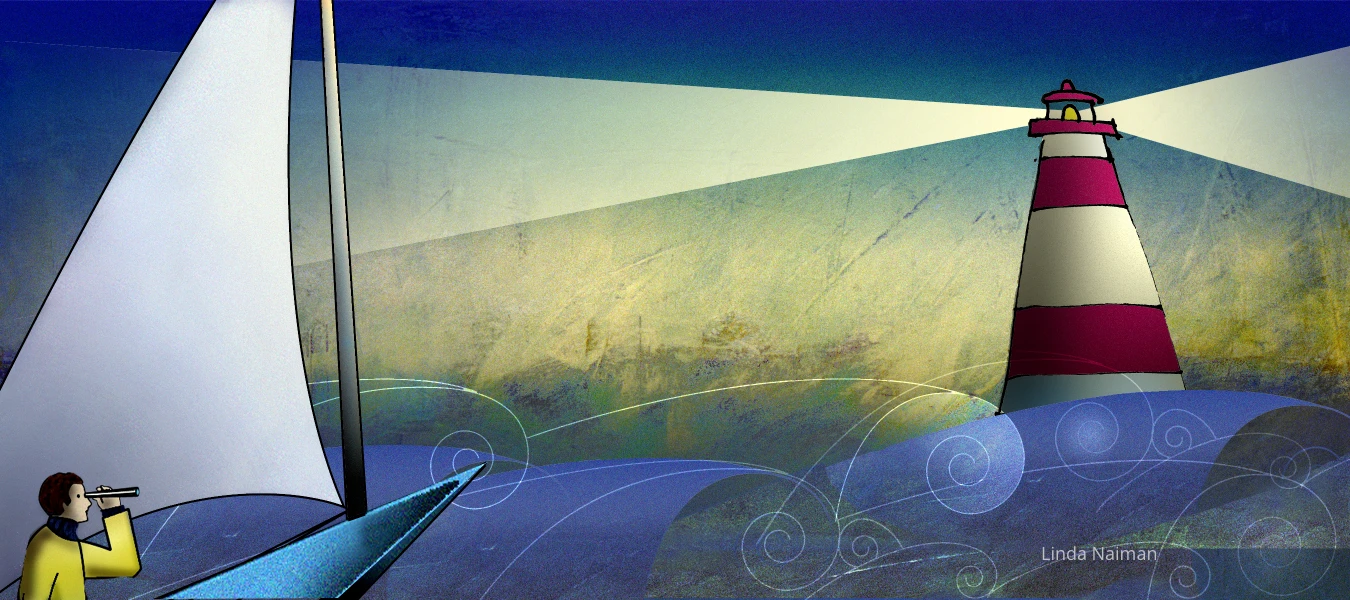To mark a milestone year, I walked the Camino de Santiago and discovered more than I expected!
When does a Camino begin? By that I mean the legendary Camino de Santiago (Also known as Camino de Compostela)
For me, it began five years ago after a three-day hike at Mount Baker with my friend Linda. I said, “Well, that was fun. Why don’t we walk the Camino?”
“Yes, let’s!” said Linda, and I said let’s do the walk in five years when we both have milestone birthdays. And so, it began.
I had seen The Way, starring Martin Sheen (AMZN) and found the movie an inspiration, not just for the grumpy spirituality of a grieving father, but the gorgeous, ancient path of the pilgrim that is the Camino, and the camaraderie of communal dinners shared over a glass of wine.
Preparation and Commitment
Five years gave me plenty of time to get healthy and fit. I had aches and pains in my knees after walking 15 kilometers, especially downhill, and I wondered how I could manage 20k a day. I also had plenty of time to worry about what could go wrong. What if I got sick? What if this happened on the trip? My inner judge whispered endless “what ifs.”
Two years before the trip, two other friends joined us. Linda asked,“Are we committed?”Gulp. Yes. One year before, we got clear about what we wanted.
We chose to walk the last 120k of the Camino from Valença, Portugal, to Santiago. I jokingly called it the Princess Route because it didn’t involve hiking across the Pyrenees, and we booked a travel service to arrange hotels and luggage transfers.
No hostels, no heavy packs. If I had to carry everything, half my bag would be supplements and shoes. Safety mattered too, and we liked having 24/7 support in case of emergencies.
The Deeper Meaning of a Pilgrimage
As plans took shape, I began to wonder: What might this pilgrimage mean at this stage of life? Could it offer magic, renewal, transformation—beyond the physical challenge? We weren’t Catholic pilgrims, but each of us walked a spiritual path.
About a year before the trip, Rev. Alisdair Smith posted something on Facebook that stopped me in my tracks: The Hero’s Journey, he said, is all about young people. Drawing on psychiatrist Allan Chinen, he noted that these kinds of fairy tales and myths end with “happily ever after.” But what happens after?
These are provocative ideas and questions I hadn’t considered before. Initially, I pushed back but my perspective shifted when I read Chinen’s books.
What stands out in “Once Upon a Midlife” (AMZN) is this: midlife is filled with hard work and drudgery. Renewal comes through facing and processing life’s difficulties. However magic returns in the second half of life, but it is a different kind of magic. It comes through a quest for wisdom, fulfillment, and wholeness.
When I reflect back on my adult life thus far, I experienced plenty of magic in my 20s and 30s and plenty of drudgery later. When was the last time I experienced magic? I wanted it back.
So, when Vancouver musician Nathen Aswell told stories about the magic he experienced on the Camino, I was all in.
Training
I thought I would have plenty of time for hiking before the trip but it turned out not to be the case. I was going full out, planning a month-long trip across Europe, and preparing for clients in Macedonia and the UK. All I managed were 18-22k walks, but never two days in a row.
In the months leading up to the Camino, I worked on strengthening both my physical and mental fitness. I prepared, strategized, trained, and set intentions. Still, I was worried about having the energy to keep up.
To my surprise, not only did I manage the 20k walks, but I also spent a week with a client in Macedonia beforehand. What made the biggest difference? Letting go of the daily news cycle and the drain of negativity. I had space to listen, to be present, to just be.
Dreams and Intentions
My dream expanded: to experience magic, mystery, miracles, and transformation on the Camino. My deeper desire was to let go of the past—bad habits, self-defeat, self-sabotage, and emotional baggage.
In short, to release everything that held me back—to emerge reborn, evolved, more connected, and living with ease, grace, peace, and flow.
I also dreamed of freedom, beauty, transcendence, and camaraderie—especially at those communal dinners at long tables, seated outside, engaging in fascinating conversations with other pilgrims over a glass of wine.
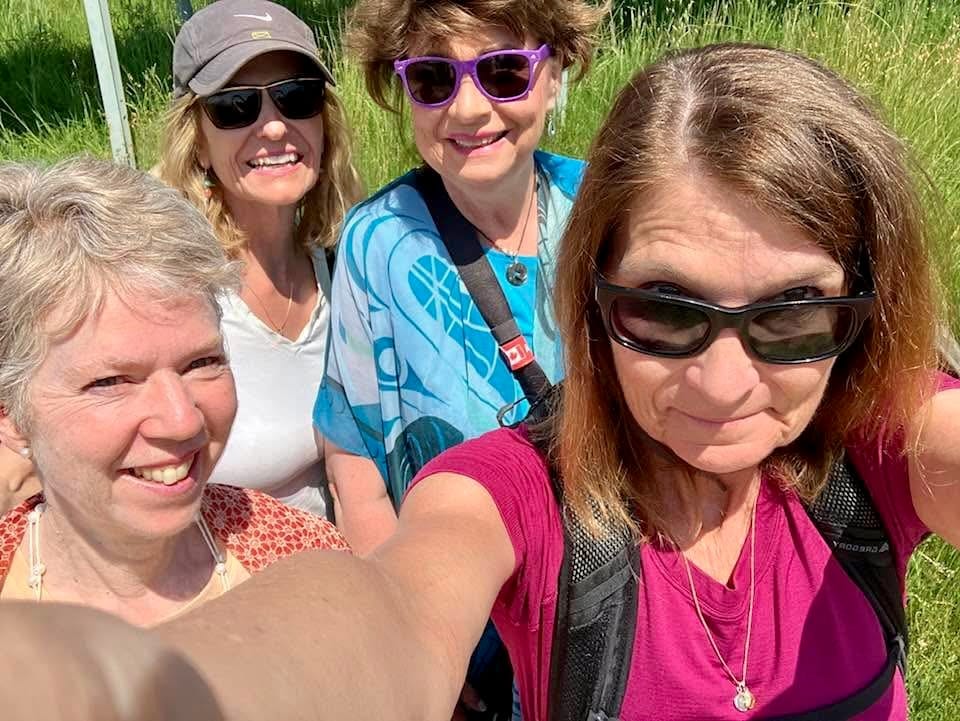
Our first day on the Camino de Santiago
L.-R.: Linda N, Linda P, Janet, Ann Marie.
May 29
The Departure
“As you start to walk on the way, the way appears.” – Rumi
The four of us—Linda, Janet, her sister Ann Marie, and I—arrived in Valença, Portugal, excited to start our week-long journey. A representative from the travel agency greeted us at our hotel and gave us an overview of each day.
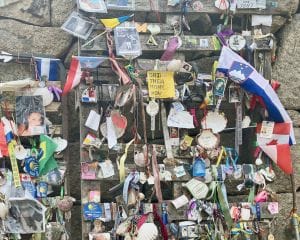
A community altar on the Camino is an informal shrine where pilgrims leave offerings, crosses, or mementos—creating a shared space of memory, reflection, and connection along the journey.
She explained some of the Camino rituals, such as greeting other pilgrims with Buen Camino and leaving a stone at makeshift altars along the way as a symbol of what you want to release on your journey. She then gave each of us a scallop shell to hang on our backpacks.
The scallop shell is one of the most iconic symbols of the Camino de Santiago (which means The Way of Saint James). The shell’s grooves, all converging at a single point, symbolize the many paths pilgrims walk, all leading to Santiago de Compostela, where Saint James the Greater, one of Jesus’ twelve apostles, is believed to be buried.
Saint James was martyred in Jerusalem. His body was miraculously transported by boat to the coast of Galicia, where it was discovered covered in scallop shells. The shell thus became a symbol of pilgrimage, miracles, and divine guidance. Not only does it identify pilgrims, it also serves as a welcoming marker to guide us along the way.
That evening, we headed out for a wonderful curry dinner. On returning, we saw one of the guests at our hotel—an elder pilgrim—lying prone in an ambulance. I took that as a warning to be careful in the heat.
May 30
We set off on our journey under a sunny 29ºC sky, grateful that the agency was transporting our luggage. We walked through the ancient fort of Valença, visited our first historic church, then crossed a bridge over a magnificent river—and just like that, we were in Spain.
As we walked past the river and into the forest, a tall, dark, and handsome Irishman—retired from the Royal Navy—joined us for a while and sang the Camino song (by Dan Mullins). He taught us the chorus, and we sang with him:
“Somewhere along the way, I hope you find what you are looking for.”
Then he told us he had to push on and walk at his own pace, and advised us to do the same. I was relieved our group agreed, because it’s exhausting to walk too fast or too slowly. He headed off, and we never saw him again. Looking back, I realized that was a magical moment.
Later, one member of our group suffered from heat stroke, and miraculously, a taxi appeared down the road. We sent her ahead to our next destination and continued walking. Nathen was right: the Camino provides.
When we arrived at our hotel, we were shocked to discover it had no elevators, and our rooms were on the third floor. Our heavy suitcases were waiting at the bottom of the stairs, and I could not lift mine even one step. We just sat on the stairs with our luggage until some kind men helped us. We ended the day with dinner and a well-deserved sangria.
Walking Through History
We didn’t get up at 5 a.m. and walk in the dark like other pilgrims. We headed out around 9 after breakfast at the hotel. This day offered some of the prettiest countryside of our trip: fields and vineyards, gardens scented with jasmine, Baroque churches with altars made of gold, filled with angels and Madonnas.
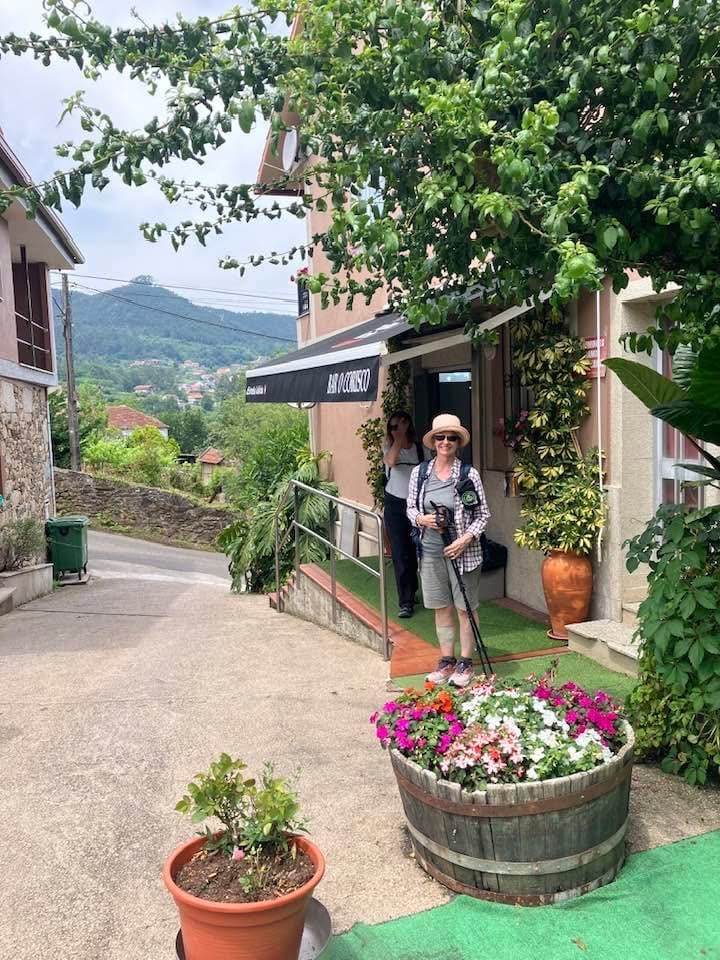
Albergue O Corisco
Near Redondela on the Camino Portugués.

Parts of the Camino de Santiago intersect with the Roman way, marked by stones like this one.
Near Mos, we encountered a tall, rough, bullet-shaped stone dating back to Roman times—a 2nd-century milestone on the Via Romana XIX, a Roman military road still visible along the Camino Portugués. This section of the route features Roman stones, walls, and bridges integrated into the pilgrimage path.
One of the pleasures of the Portuguese Way is the variety of landscapes: farms and vineyards, babbling brooks and rivers, hamlets, villages, towns, and cities; mountains and meadows; ancient pathways, cobblestones, and forests; country roads and highways.
I paid a lot of attention to looking.
Look back to see where you came from. Look up, down, and sideways too.
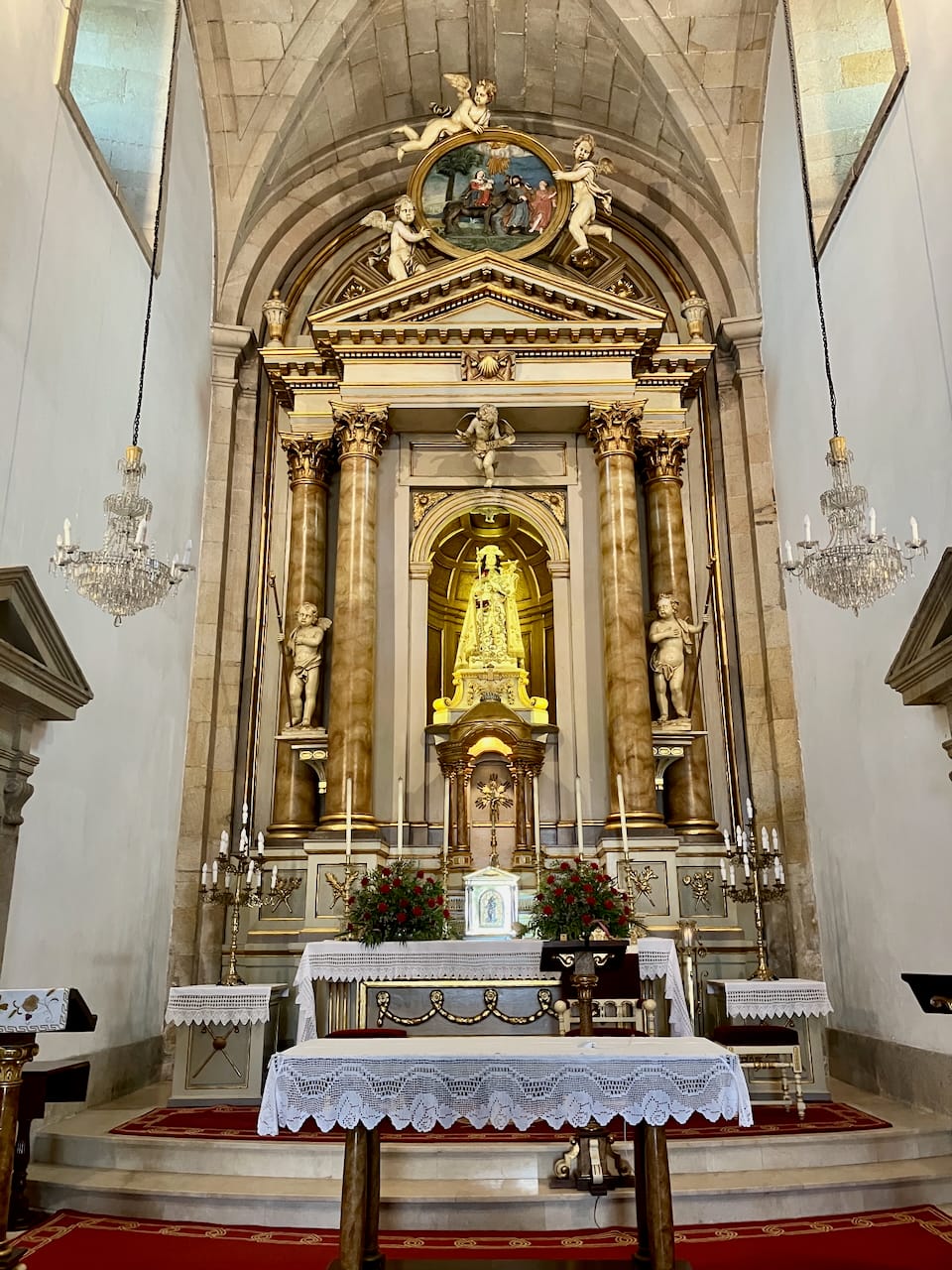
Iglesia de la Virgen Peregrina, Church of the Pilgrim Virgin, Pontevedra
This is such a beautiful and serene altar. Notice the scallop shell near the top.
Voices Within and Numinous Reflections
I paid attention to the interior chatter of my mind, the whispers of my soul and the voice of judgement. Am I doing this right? I wondered. I reminded myself everyone has their own Camino.
The Spanish poet Juan Ramon Jiminez wrote:
I am not I.
I am this one walking inside me
Whom I do not see.
Whom at times I manage to visit,
And whom at other times I forget…
As I practice a walking meditation, I focus on being aware that I am the awareness. I am this one inside of me, taking it all in, observing silently.
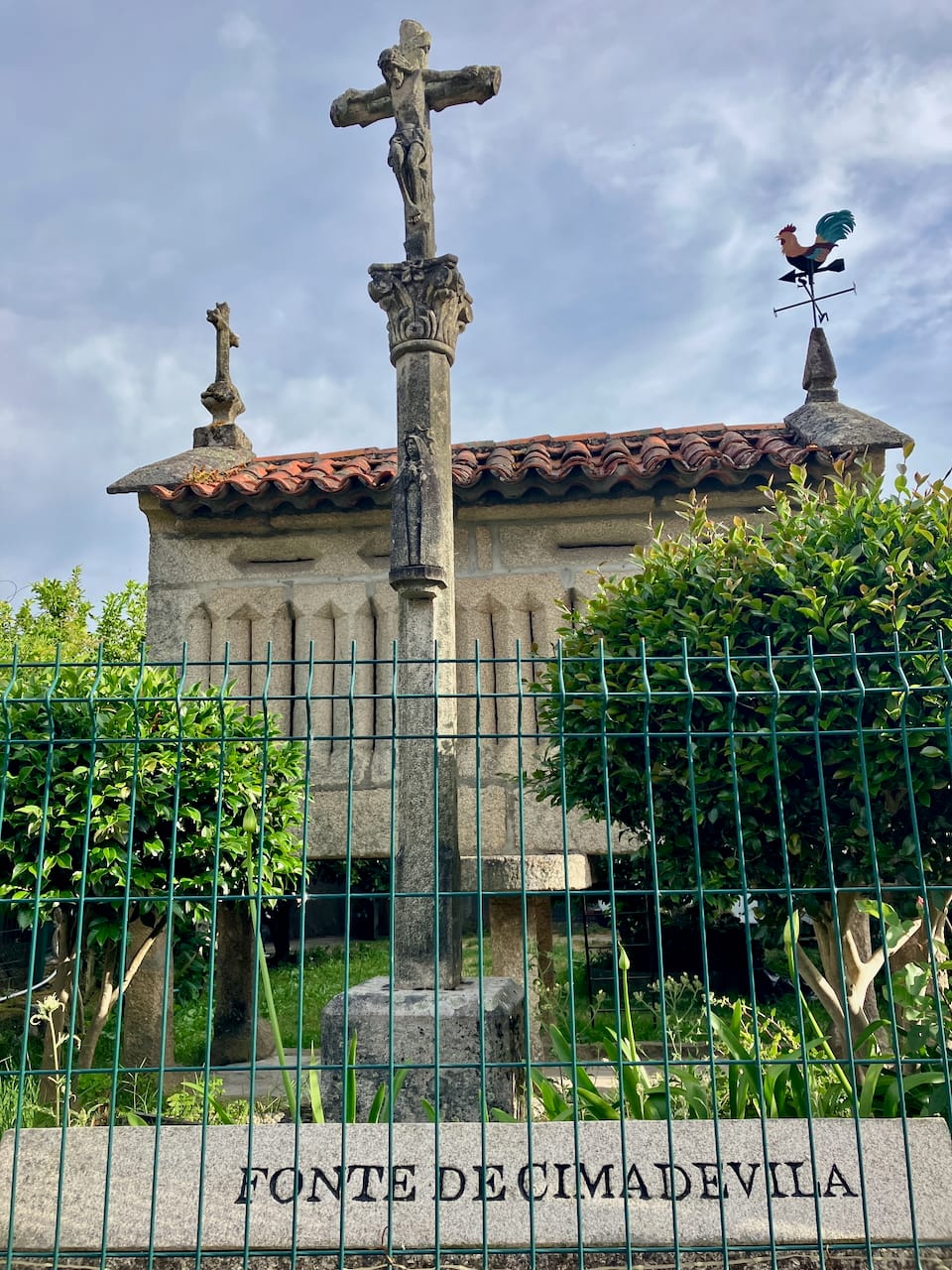
“Horreos” used for grain storage, especially corn.
Many homes have these in the province of Galicia
June 1
Beauty and Connection
Beauty everywhere. I loved the Roman bridge. Birds chirped, frogs croaked in a pond we passed, grapevines were forming their fruits, and we enjoyed the scent of jasmine, eucalyptus, and roses along the way—not to mention the earthy smell of cows, soil, and grasses.
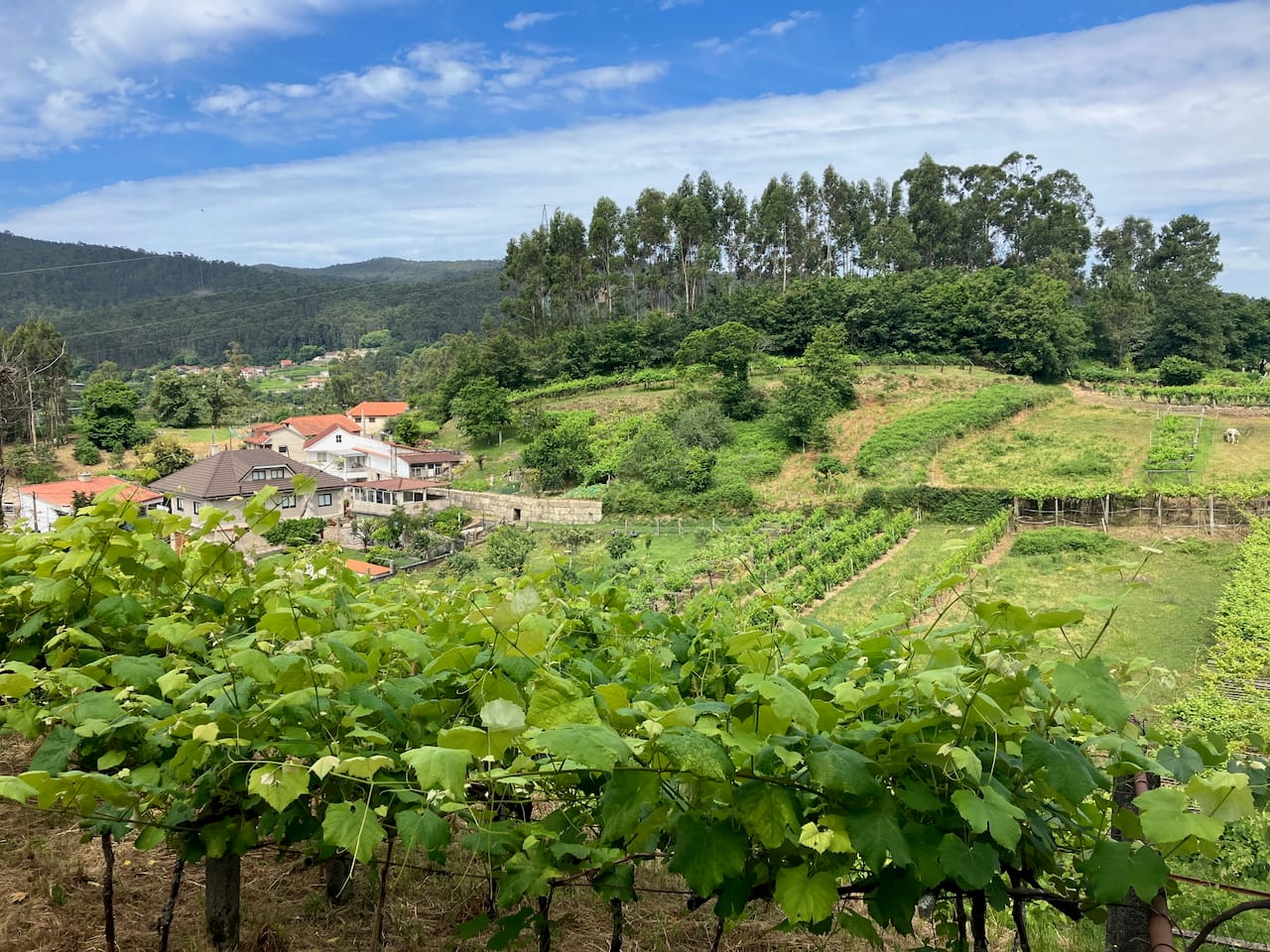
Vineyard, Vilaboa, Rías Bajas Camino
Rolling vineyards stretching across Galicia, a visual reward for the trail.
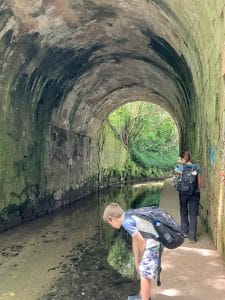
I was charmed by the curiosity of this liitle boy.
Everyone was friendly, and we felt welcome everywhere we passed through. I tried to imagine what pilgrims experienced here hundreds of years ago.
On this trip, we encountered families celebrating graduations. Couples on a pilgrimage to honour the passing of a parent. Church groups on a spiritual pilgrimage, and other groups simply on holiday.I was surprised to see many women walking alone with full packs. One was walking the Camino to heal from a breakup.
Everyone has a story, and some wonder why they are here. Each one is starting a new chapter, even if they don’t know the reason.
I tuned in to all those who had passed before over the past 1,000 years—their thoughts, their faith, the power of the path, the sacredness of it all. I allowed myself to slow down and feel the sacredness of the path underfoot. Every step became a prayer.
Team Spirit
It was the first time our group of four had traveled together, and naturally, we encountered a few challenges along the way. Each of us brought different gifts and talents that made our little team resilient. We made a conscious effort to notice and meet one another’s needs, while also giving space to walk at our own pace.
Sometimes we walked together as a group, sometimes in pairs, and sometimes in solitude. We were fluid with one another.
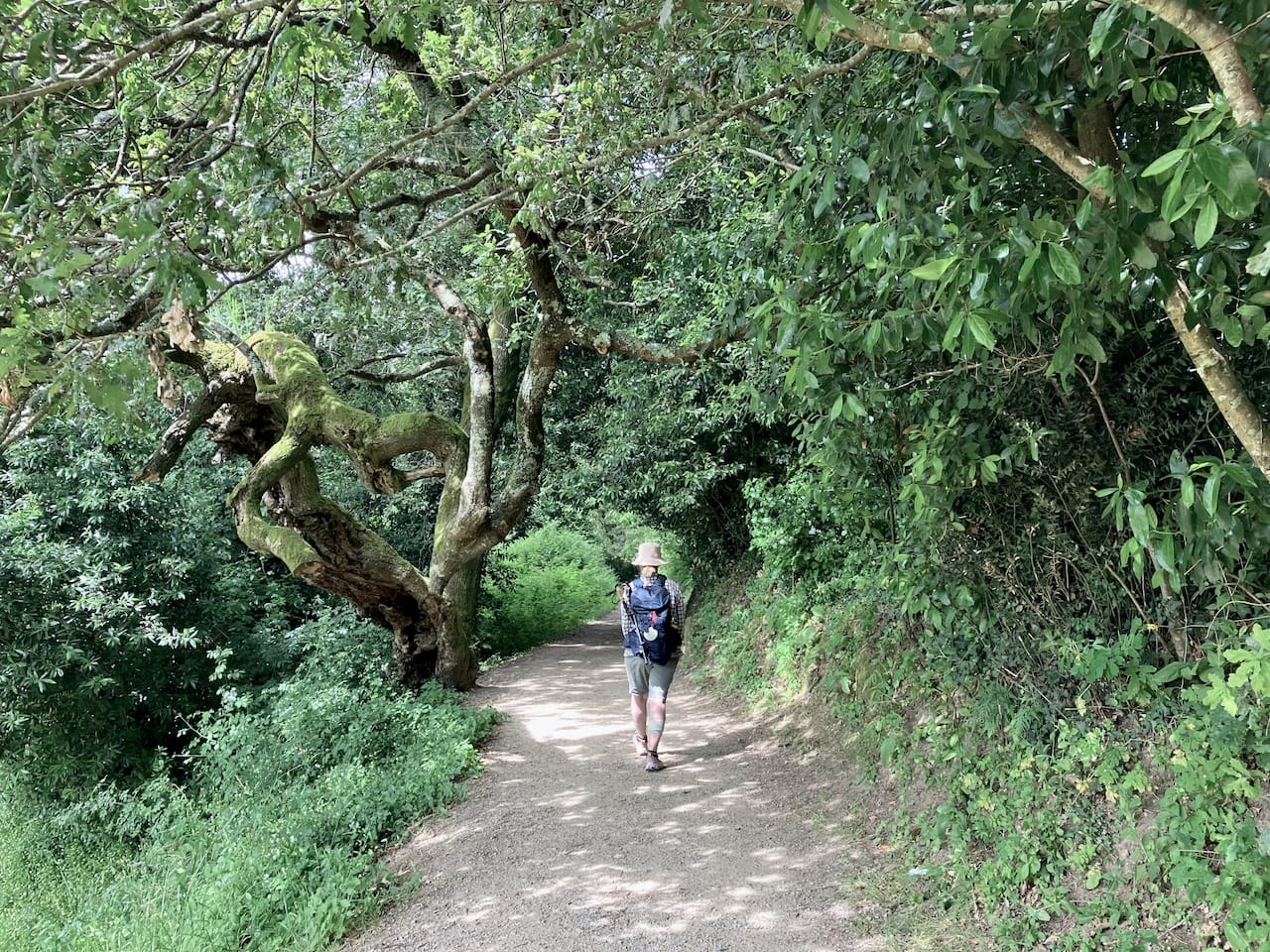
Passing through a cork oak forest on the Camino de Santiago
Cork bark is harvested sustainably every 9–12 years, so the trees are a living example of renewable resource use without harming the environment.
During the first couple of days, we chatted a lot, and as the days passed, our rhythm shifted—silence became its own form of companionship, with each of us present to our breath, the beauty around us, and the sounds and sensations of the path.
Each morning, we set out with curiosity and gratitude—celebrating how far we had come, and how the distance left to Santiago kept shrinking.
June 2
A Turning Point
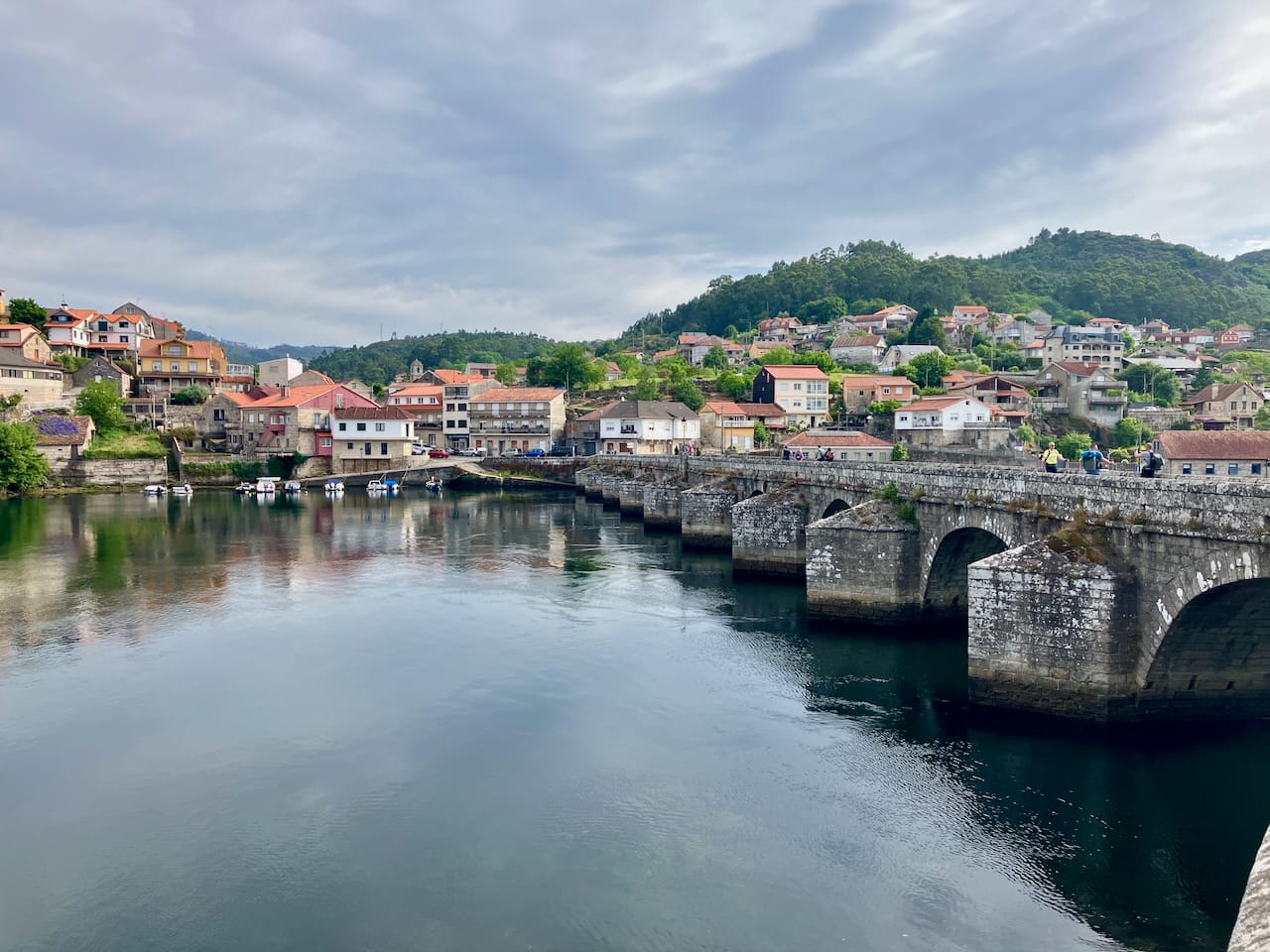
Medieval Bridge at Soutomaior
Rebuilt from Roman times
Day four was a rest day in Pontevedra. We had fantastic meals in the Galician tradition. Fish, seafood, and grandmother cakes.
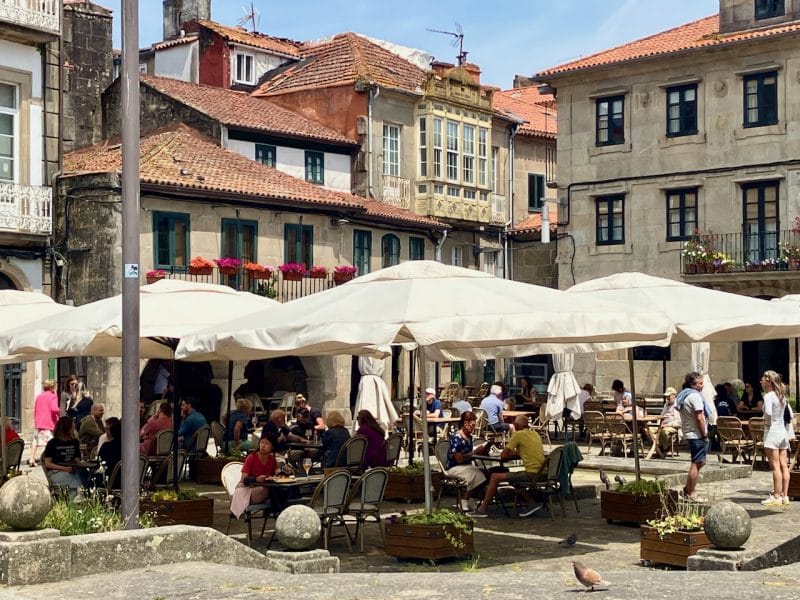
A scene from Pontevedra’s medieval neighbourhood .
The town is not very touristy and we got to see locals enjoying themselves over coffee and long lunches. We were very tired but still walked 10k just to explore the magnificent churches.
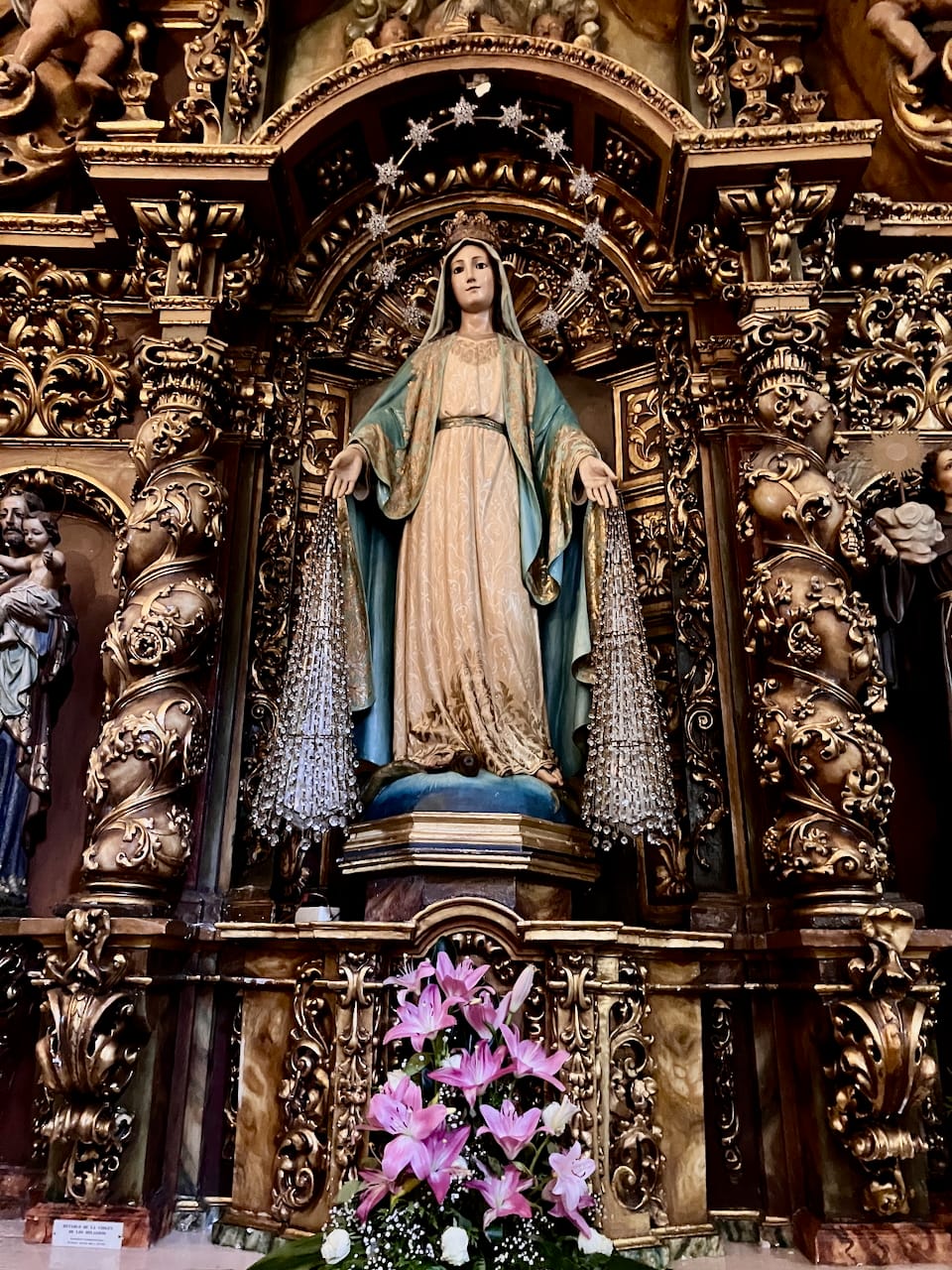
Iglesia de la Virgen Peregrina—Sanctuary of the Pilgrim Virgin
As I walked out of Saint Bartholomew Church, I approached a man in a suit and tie and asked about the crowd at the door.
“Is it a wedding?”
“No,” he said, clasping both my hands.
“It might seem like that because everyone is happy, but it is a funeral for my mother. We are happy because now she is in heaven with my father.”
As he told me this, something inside me started crumbling and I started to tear up. I slid my hands away from his, offered my blessing of condolences, and ran off in tears to join Janet across the road. We went back to the hotel, and the tears continued as I went to my room.
Linda, who was having a nap, woke up, jumped up onto my bed and asked what was wrong.
“I don’t know,” I sobbed, “I think it might be grief.”
“Okay,” she said, “Feel what you need to feel,” and she went back to her nap.
What I came to understand later was the tears were deep grief and the release of emotions I didn’t even know I had. It wasn’t about the man who lost his mother, and while they were likely related my own mother’s death six months earlier in January, emotions coming to the surface felt like the accumulation of a lifetime. This was not the transformation I had expected, but I welcomed it, and let my emotions be.
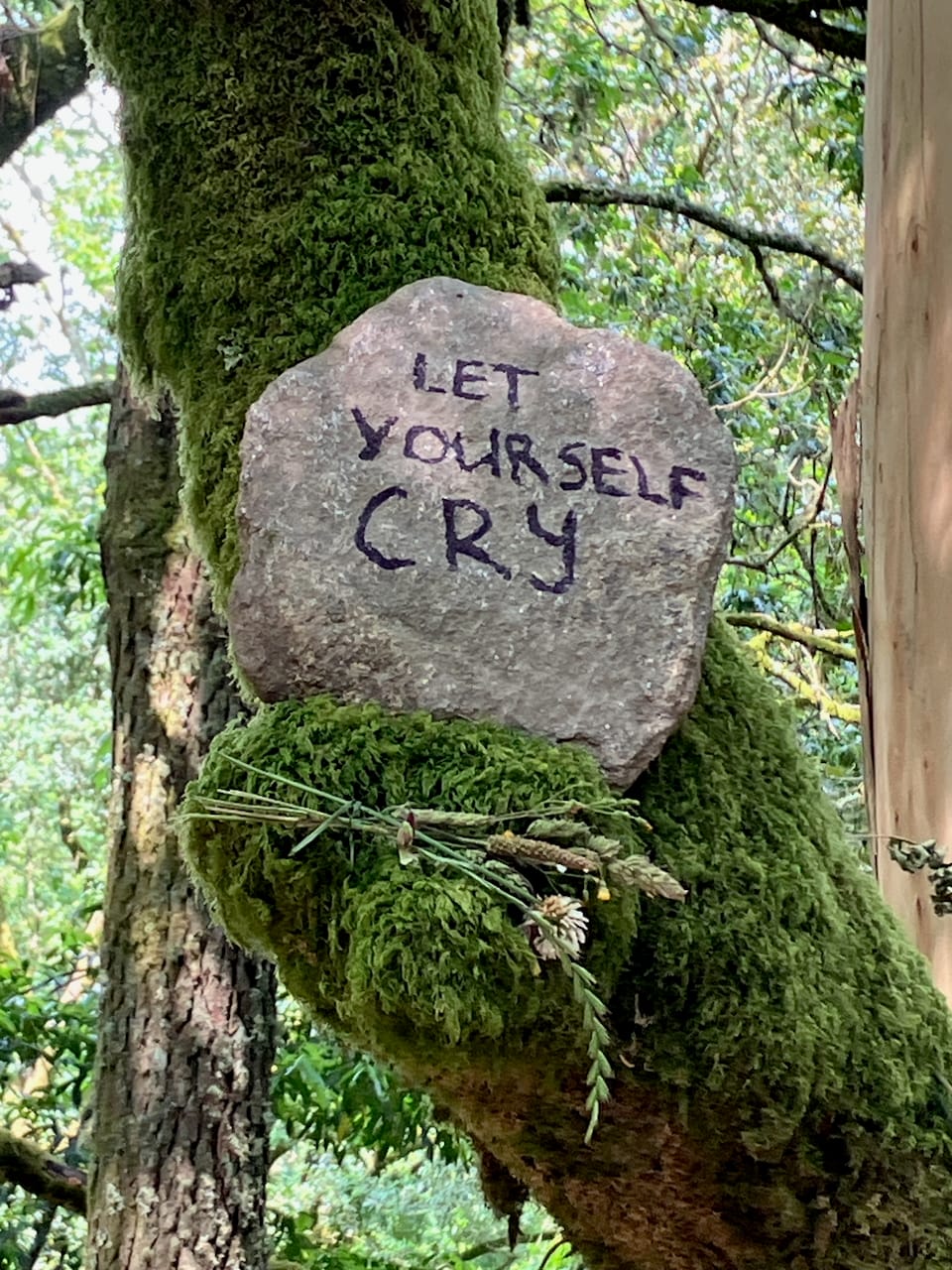
Let yourself cry on the Camino
My sentiments exactly
I practiced a walking meditation with a focus on paying attention to my emotions—to feel them, accept them, to remind myself to have empathy and compassion, and to let them pass.
I also practiced being as present as possible to each moment, to feel gratitude for the journey and to let go of the millstones that have held me back.
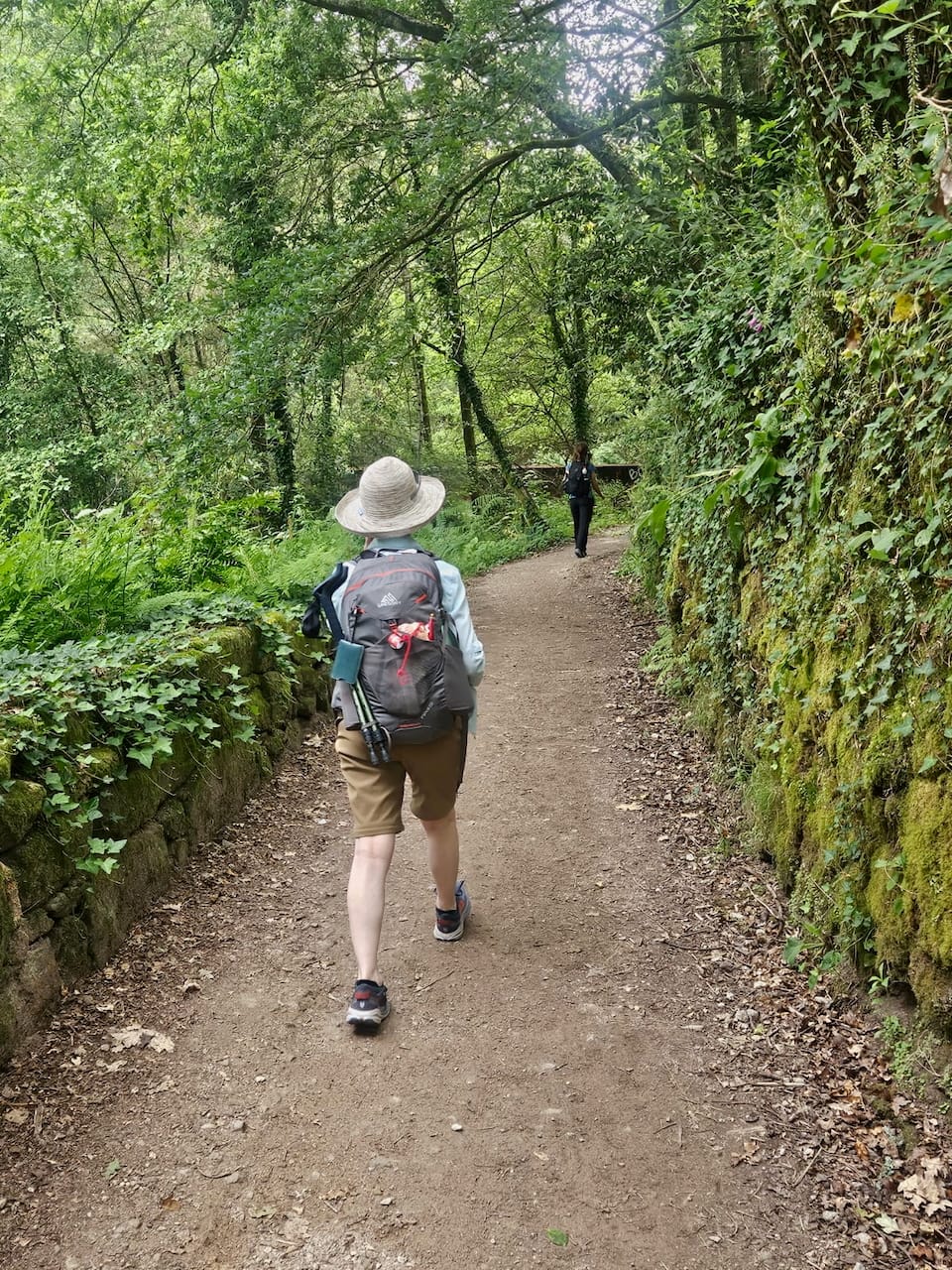
Hitting my stride with Ann Marie up ahead.
June 3
Illness and Inner Strength
I came down with a cold and it was just too hard to write even the shortest of journals. I thought of taking a taxi to our next hotel, but decided against it. It’s the Camino after all, and the Camino provides, so I carried on. As I walked, I affirmed that even though I was walking, I was deeply resting and healing within.
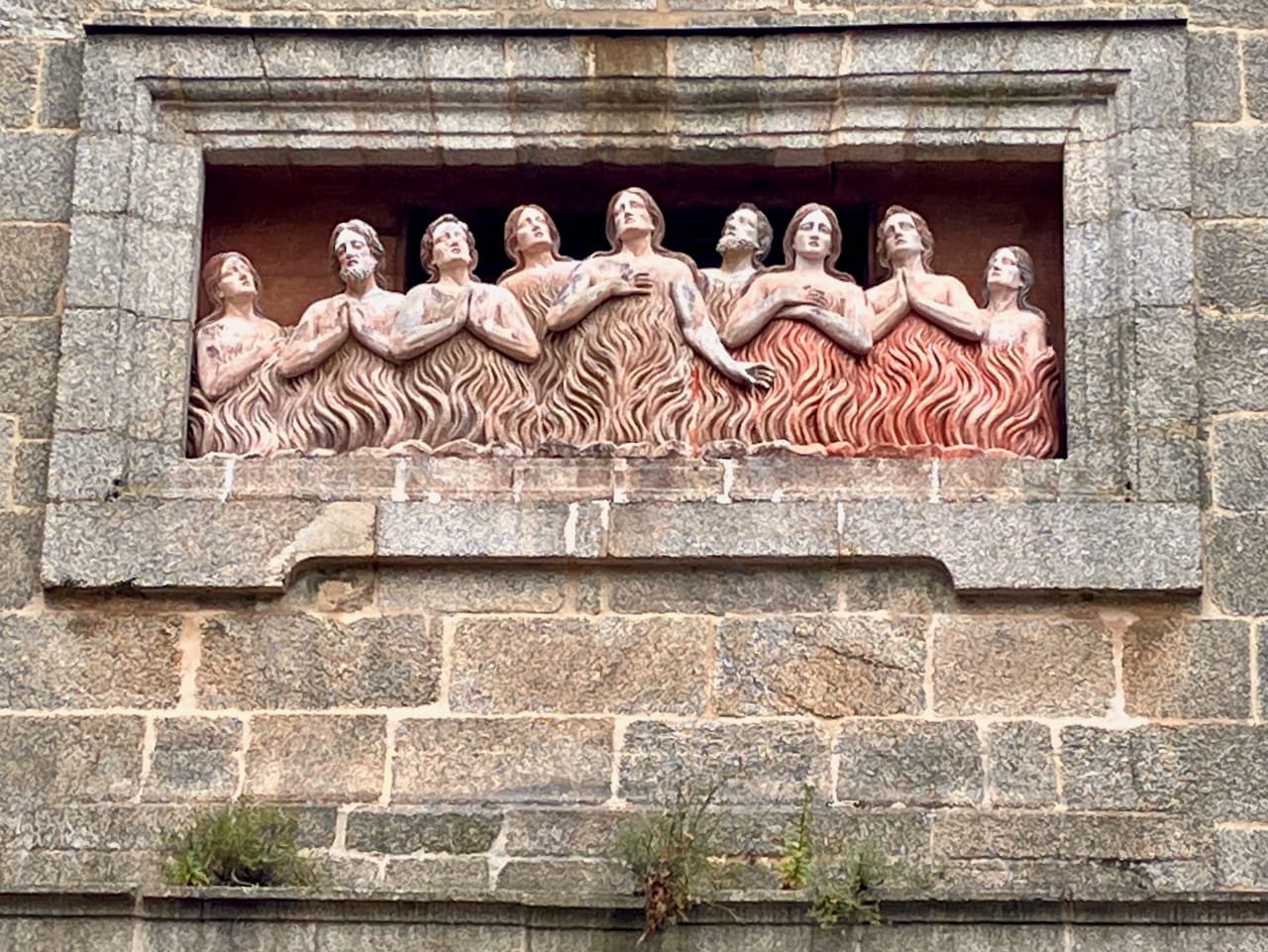
Capela de Ánimas (Chapel of Souls) in Santiago de Compostela, Spain.
The figures are shown amidst flames, a common visual metaphor for the cleansing process in Purgatory. The Capela de Ánimas is a UNESCO monument.
June 7
Arrival in Santiago
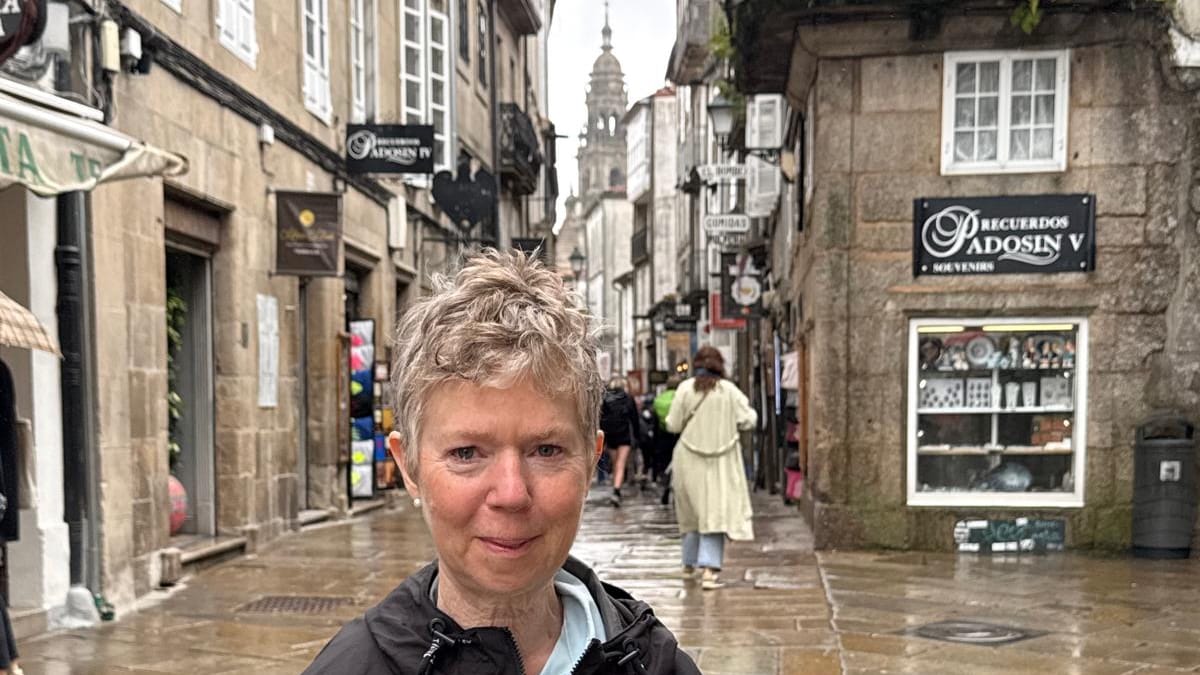
First View Santiago Cathedral Spire
I felt very emotional seeing the spire for the first time.
We made it to Santiago de Compostela! What a journey!
Two of us had colds for a couple of days, but we flowed through because that’s what you do on the Camino.
As we trooped up a narrow medieval road toward the cathedral, we caught our first glimpse of the spires. It was a deeply emotional moment, and I was flooded with tears once again.
Perhaps it was the exhaustion of walking 120 kilometers, compounded by a cold. The rhythm of walking for days on end loosened whatever emotions had been stored in my body—grief, trauma, regrets. Or maybe it was the convergence of my inner and outer worlds as we reached our destination.
As we entered the main square and approached the cathedral, my tears continued. I felt a deep sense of connection to something magnificent: God, the universe, the soul, and a lineage of pilgrims across centuries.
Reaching the cathedral wasn’t just a destination. I felt a convergence of history—including the crusades—of pilgrims, myth, religion, spirituality, and our shared humanity.
On this day, we saw the arrival of many pilgrims. What caught my attention were several youth groups jumping for joy and celebrating their arrival with cheers. I’m told walking the Camino is a rite of passage for Spanish youth.
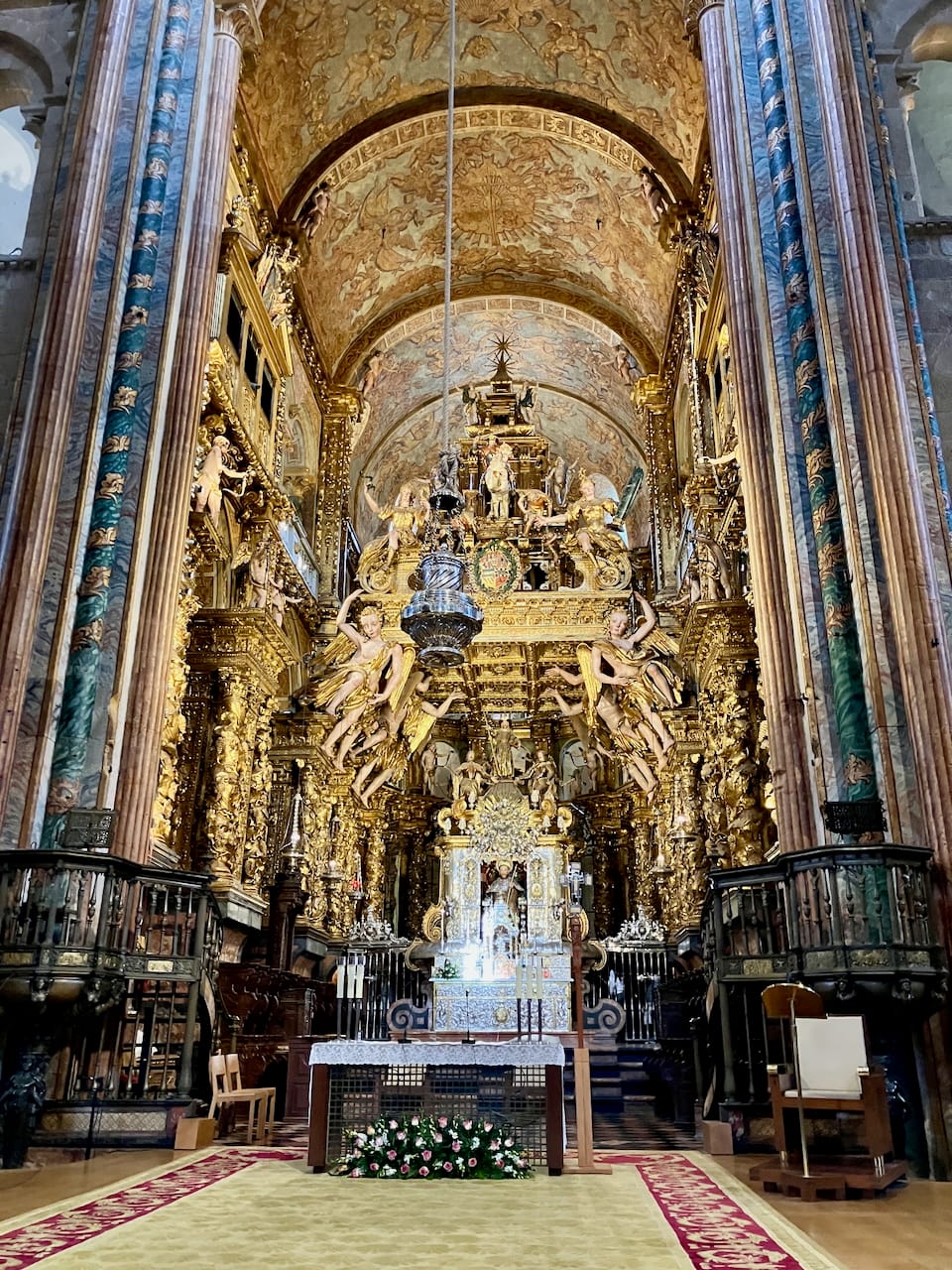
Altar of the Santiago Cathedral
Once inside, I was awed by the size of the main altar, the largest I have ever seen. It is adorned with gold, silver, and precious stones and must be at least three stories high.
Designed by Fernando de Casas y Novoa and executed by master sculptors over more than 20 years, it is considered to be one of the most impressive Baroque altars in Spain.
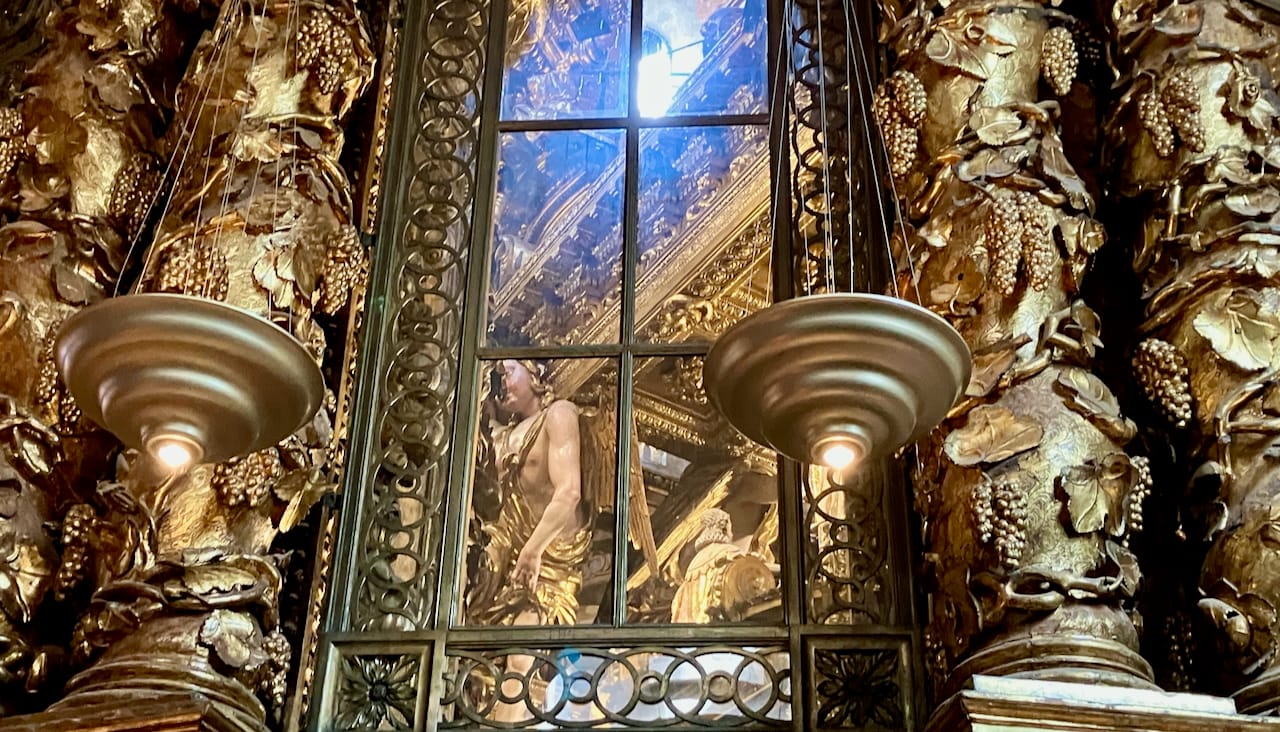
Details of Santiago Cathedral altar
I was amazed by all that gold!
As I wandered around the nave, I noticed large rooms serving as confessionals, each adorned with antique furniture, paintings, and muted fabrics. Inside each room, a priest and a confessor sat in quiet conversation. These scenes looked like tableaux for a painting—so beautiful I longed to take a photo, but I chose to honor their privacy.
At lunch I asked everyone if they would do the trip again. Nope, everyone said they were done. I was done too. We were so exhausted.
Funnily enough, six weeks later, Ann Marie shared on WhatsApp that she wanted to walk the Camino again. And that got me thinking, hmm, it would be interesting to walk the French Route, and now all four of us have decided to take this journey for our next milestone in five years.
Gastronomy and the Last Supper
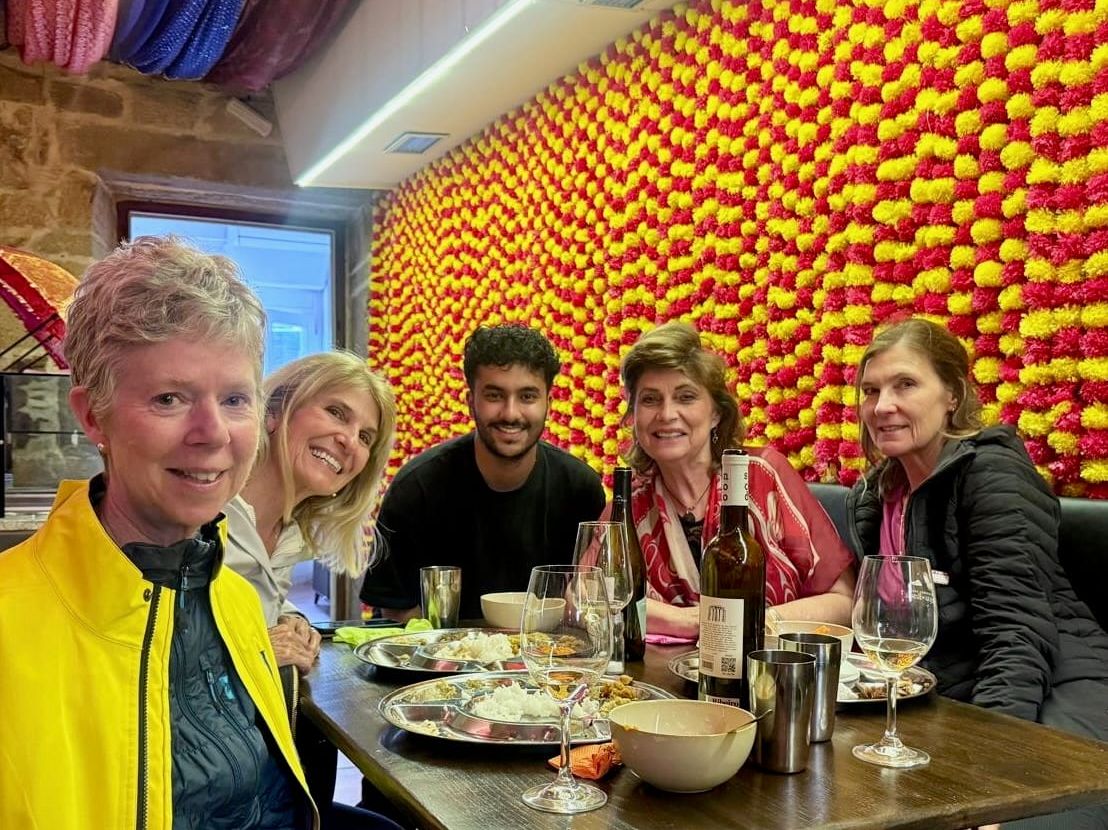
Our last supper in Santiago
Celebrating the completion of the last120 kms of the Camino.
Santiago is a center for gastronomy and boasts two Michelin-starred restaurants. Pilgrims love to eat and drink, especially when they reach Santiago. We saw plenty of pilgrims laughing and indulging as we passed cafés and bars on our way to the cathedral.
We reached the end of our journey and we were ready to celebrate. Our last supper was at a curry restaurant that had just opened. At first, they wouldn’t let us eat there because they weren’t sure if they had enough food.
They were charming but disorganized. It took five minutes for the chef and our server to clear the confusion about whether my dinner—vegetarian, no tomatoes—was mine, or if it belonged to Linda who ordered vegan with tomatoes. We drove servers crazy on this trip with our food preferences.
Never mind. We still celebrated.
Transformation and Integration
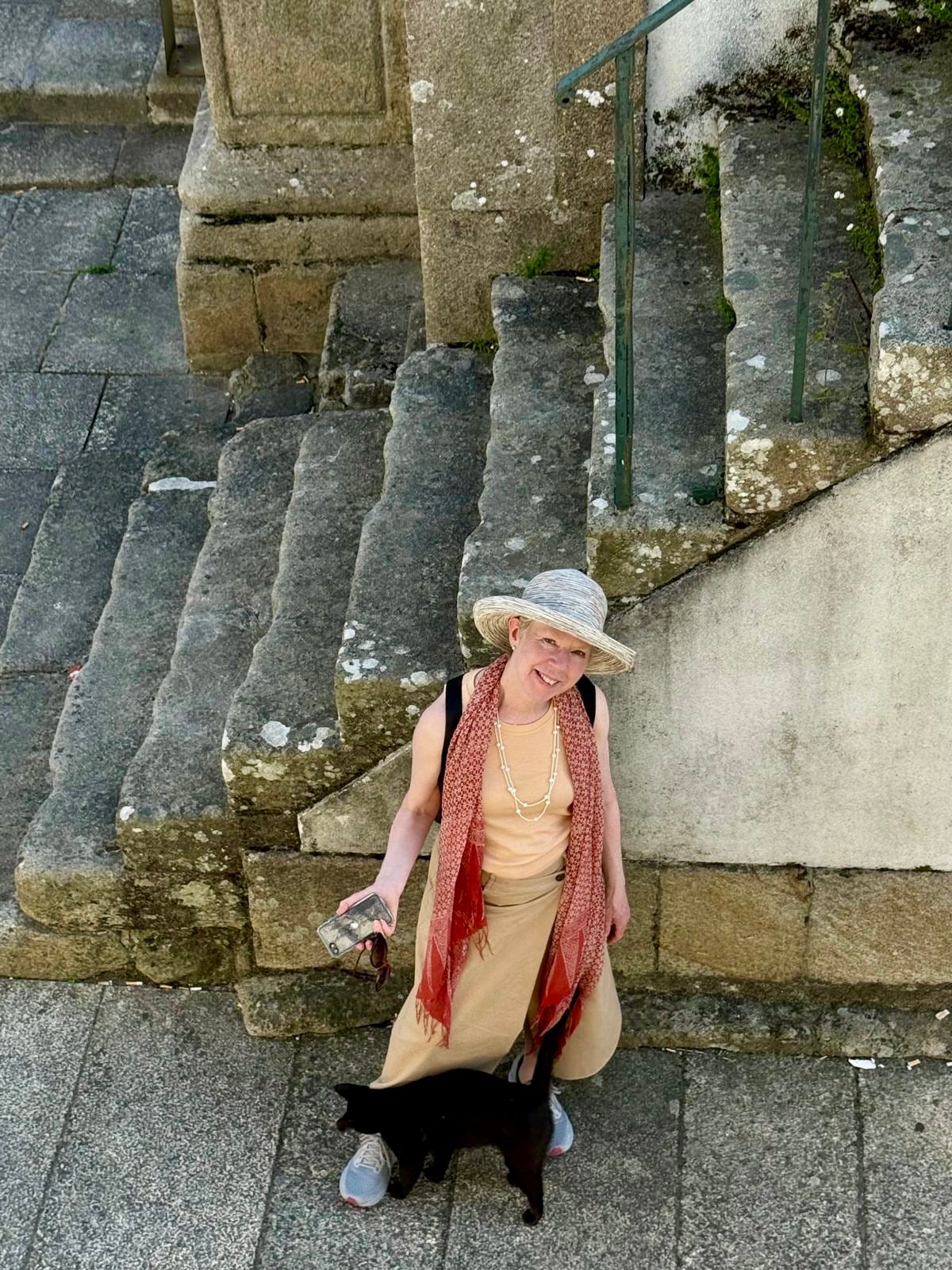
Looking up
Did I find what I was looking for on the Camino?
The journey transformed what I thought my limits were—and miraculously, my knees and hips never bothered me. The Camino pushed me to go further and have the strength to do so. It connected me to the Creator, to history, tradition, and a thousand years of pilgrims—to their hopes, dreams, aspirations, longing, and suffering.
It connected me to the power of place. A place draws its strength from what people bring to it—art, symbols, homes, churches, towns, farms—and from nature’s own forces: sun and rain, wind and water, earth and stone, trees and the songs of birds. Together, they are the living essence of the land.
Mary Oliver’s poem “Sometimes” captures some of what I experienced on our journey:
Instructions for living a life:
Pay attention.
Be astonished.
Tell about it.
The Camino changed me, but not in the way I imagined. One of my deepest desires was to release my old personality—the one burdened by bad habits, stress, fears, and grievances—and to live with more ease, grace, peace, flow, and joy.
Two weeks after returning, some of my old patterns crept back, and I wondered if I had truly transformed. My inner judge whispered, “How can you expect to change your life in a week?”
When a friend asked me how I responded to my old self, I said, “With compassion.”
“Good answer,” she replied.
I give myself the gift of time and space to process, to heal, and to savour the extraordinary experiences I had. Transformation isn’t a one-time event; it’s a practice. We release, we renew, and we begin again. The magic, the miracles, and the mystery are always present. We just need to pay attention.
I have come to realize the Camino is not a path you finish. It is a song you carry home.
Want to explore your own path of transformation?
If my Camino stirred something in you—curiosity, longing, or a desire for change—I offer coaching to help you navigate your journey, whether you’re closing a chapter or beginning a new one, with clarity, courage, and creativity.
Feel free to book a 15 minute consultation—let’s explore together.
…and if you enjoyed this story, I invite you to read my poem The Song I Carried Home
The View from A Broad Podcast
You might also enjoy my conversation with Teresa Norton. We discussed milestones, turning 40 (and beyond), the beauty of aging, setting long-term goals, and how walking the Camino shaped my perspective.
Listen to the Podcast
The Camino is just one path to transformation—there are many.
Join my newsletter for insights, stories, and tools to help you walk your own path with creativity

